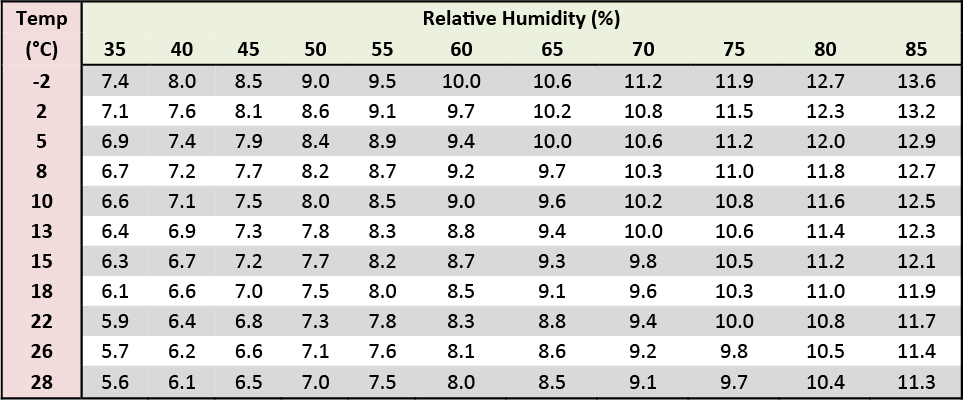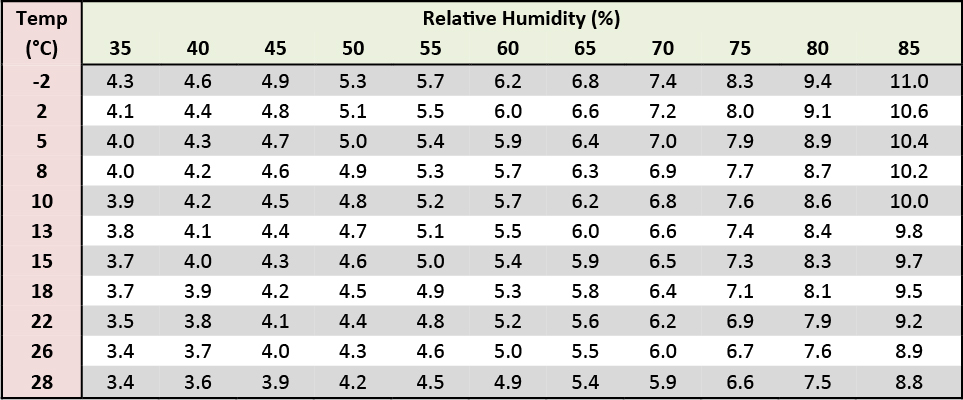Equilibrium Moisture Content Charts for Grain Storage Management
The equilibrium moisture content (EMC) of air can be used to predict how the ambient air used for natural air drying (NAD) will affect the moisture content of grain. The EMC of the air depends on its temperature and relative humidity (RH) as well as the grain type.
The EMC represents the moisture content that the grain will eventually equilibrate to if the air conditions remain constant for a length of time. Although air conditions are rarely constant for longer than an hour, the EMC information can still be used to determine the range of air temperatures and relative humidities that will achieve drying.
For example:
If the ambient air has a temperature of 10°C and a RH of 60%, the EMC of the air for WHEAT is 13.6% (refer to EMC chart below). That means that if the air conditions stay constant at 10°C and 60% RH, wheat would eventually equilibrate to 13.6% moisture content (and 10°C). Whether the wheat started with a moisture content lower or higher than 13.6% doesn’t matter; the wheat would eventually equilibrate to 13.6%.
Another example:
If the goal is to dry wheat to 14.4%, the most effective time to run the fan would be when the EMC of air is less than 14.4%. Those conditions (air temperature and RH) are highlighted in red in the chart below.
EQUILIBRIUM MOISTURE CONTENT FOR HARD RED SPRING WHEAT
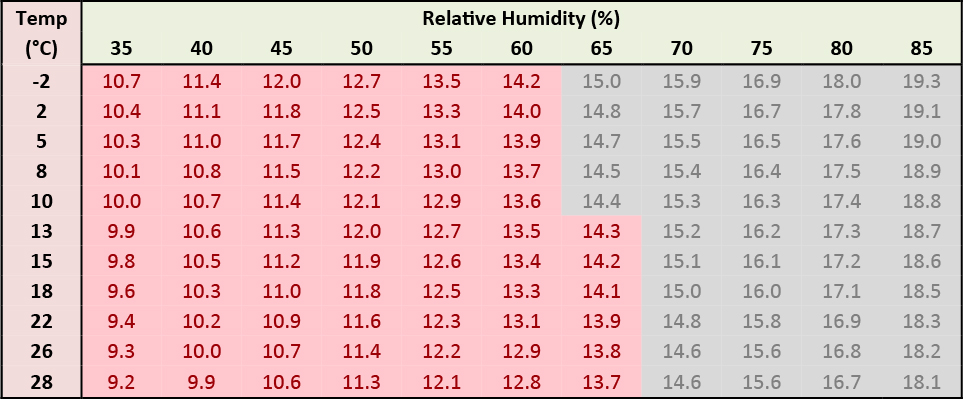
Remember:
It is also important to manage grain temperature as well as moisture content to help prevent spoilage. If you are using warm air (temperature greater than 15°C) to help dry grain, the grain will also warm to that temperature. Once the target moisture content has been reached, aerate with cool air to bring the average grain temperature below 15°C. Due to the effect of grain temperature on the air’s ability to remove moisture, this cooling period will also result in some moisture loss, so cooling can start once the grain is within approximately half a percent of the target moisture content.
Important Note:
The EMC of air depends on the grain type as well as the air temperature and RH. The EMC charts for wheat, barley, peas, canola, oats, lentils, soybeans, barley, flax, and sunflowers are presented below.
These charts are based on the moisture isotherm data summarized in the ASABE Standard D245.5 (Moisture Relationships of Plant-based Agricultural Products) and various published studies (listed after the charts). These charts use the modified Henderson model for flax, peas and canola, the modified Chung-Pfost model for flax, oats, hard red spring wheat and barley, the modified Halsey equation for red lentils, soybeans and sunflowers, and the modified Oswin model for lentils, durum and oats. Note that much of the information in ASABE Standard D245.5 is based on research conducted in the 1980’s and 1990’s. Since that time, plant breeding has resulted in different starch and oil contents of grains and oilseeds which may affect the EMC values. Therefore, these charts should be used as a guideline only.
EQUILIBRIUM MOISTURE CONTENT FOR HARD RED SPRING WHEAT
(Modified Chung-Pfost)
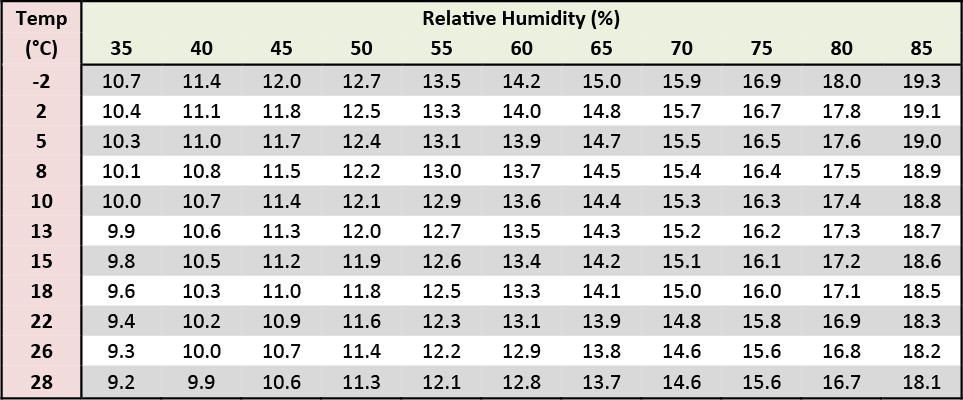
EQUILIBRIUM MOISTURE CONTENT FOR HARD RED WINTER WHEAT
(Modified Oswin)

EQUILIBRIUM MOISTURE CONTENT FOR DURUM WHEAT
(Modified Oswin)

EQUILIBRIUM MOISTURE CONTENT FOR BARLEY
(Modified Oswin)

EQUILIBRIUM MOISTURE CONTENT FOR PEAS
(Modified Henderson)

EQUILIBRIUM MOISTURE CONTENT FOR OATS
(Modified Oswin)

EQUILIBRIUM MOISTURE CONTENT FOR CANOLA/RAPESEED
(Modified Henderson)
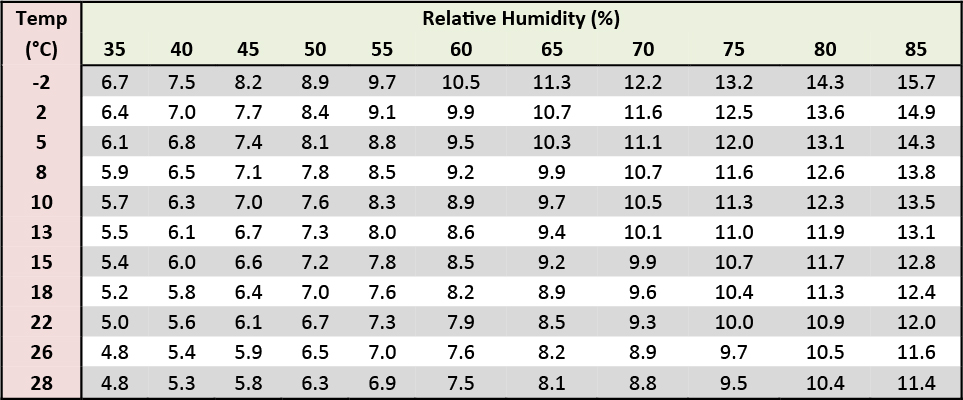
EQUILIBRIUM MOISTURE CONTENT FOR LENTILS
(Modified Oswin)

EQUILIBRIUM MOISTURE CONTENT FOR RED LENTILS
(Modified Halsey)

EQUILIBRIUM MOISTURE CONTENT FOR SOYBEANS
(Modified Halsey)

EQUILIBRIUM MOISTURE CONTENT FOR FLAX
(Modified Henderson/Chung-Pfost)
EQUILIBRIUM MOISTURE CONTENT FOR SUNFLOWER SEEDS
(Modified Halsey)
EQUILIBRIUM MOISTURE CONTENT FOR SUNFLOWER HULLS
(Modified Halsey)
EQUILIBRIUM MOISTURE CONTENT FOR SUNFLOWER KERNELS
(Modified Halsey)
BARLEY
- Model: Chung Pfost
- Source: American Society of Agricultural and Biological Engineers (2012). ASABE Standard D245.5. Moisture Relationships of Plant-Based Agricultural Products.
CANOLA/RAPESEED
- Model: Modified Henderson
- Source: S. Sokhansanj, W. Zhijie, D. Jayas, T. Kameoka (1986) Equilibrium Relative HumidityMoisture Content of Rapeseed (Canola) from 5°C to 25°C.
DURUM WHEAT
- Model: Modified Oswin –
- Source: American Society of Agricultural and Biological Engineers (2012). ASABE Standard D245.5. Moisture Relationships of Plant-Based Agricultural Products.
FLAX
- Varieties: Linnot, Dufferin, Mcgregor, Norlin, Norman (EMC chart is an average of all varieties)
- Models: Average of Modified Henderson and Modified Chung-Pfost (EMC chart is an average of both models)
- Source: G. Mazza, D.S Jayas, N.D.G. White. (1990) Moisture Sorption Isotherms of Flax Seed.
HARD RED SPRING WHEAT
- Variety: Sinton
- Model: Modified Chung-Pfost –
- Source: American Society of Agricultural and Biological Engineers (2012). ASABE Standard D245.5. Moisture Relationships of Plant-Based Agricultural Products.
HARD RED WINTER WHEAT
- Varieties: Waldron, Napayo (EMC chart is an average of both varieties)
- Model: Modified Oswin
- Source: American Society of Agricultural and Biological Engineers (2012). ASABE Standard D245.5. Moisture Relationships of Plant-Based Agricultural Products.
LENTILS
- Model: Modified Oswin
- Source: Nikolay D. Menkov. (2000). Moisture Sorption Isotherms of Lentil Seeds at Several Temperatures.
OATS
- Varieties: Dumont, Newman (EMC chart is an average of both varieties)
- Model: Modified Chung-Pfost – Source: D.S. Jayas, G. Mazza. (1993) Comparison of Five, Three-Parameter Equations for the Description of Adsorption Data of Oats.
PEAS
- Model: Modified Henderson
- Source: Chiachung Chen. (2002). Moisture Sorption Isotherms of Pea Seeds.
RED LENTILS
- Varieties: Robin, Redberry, Blaze (EMC chart is an average of all varieties)
- Model: Modified Halsey
- Source: S. Cenkowski, J. Paliwal, S. Arntfield, M. Gervais. (2015) Sorption Characteristics of Red Lentils as Affected by Postharvest Conditions.
SOYBEANS
- Varieties: Essex, Britain (EMC chart is an average of both varieties)
- Model: Modified Halsey
- Source: Z. Yang, E. Zhu, Z. Zhu. (2012). Moisture Sorption Isotherms and Net Isostatic Heats of Sorption of Green Soybeans.
SUNFLOWER SEEDS/HULL/KERNEL
- Model: Modified Halsey
- Source: G. Mazza, D.S. Jayas. (1991). Equilibrium Moisture Characteristics of Sunflower Seeds, Hulls, and Kernels.
